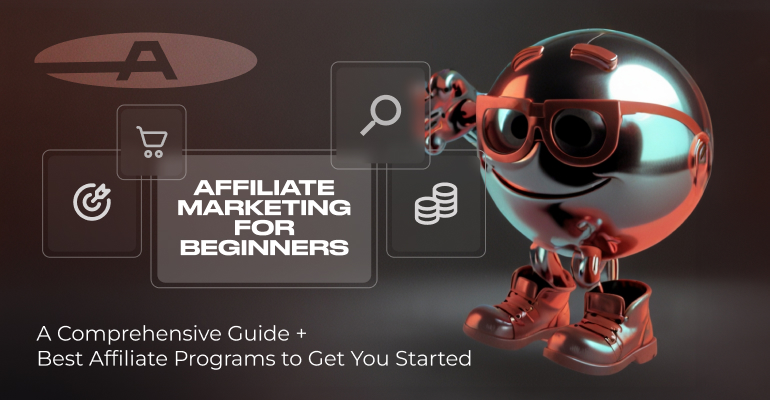
Affiliate Marketing for Beginners: A Comprehensive Guide + Best Affiliate Programs to Get You Started
Affiliate marketing can feel like a maze when you start—many choices and questions exist. Which programs should you choose? How do you effectively monetize your content? I remember being excited by the potential for big commissions but overwhelmed by all the options. In this guide, I'll simplify the process for you, sharing my experiences and key lessons to help you start earning confidently.What is Affiliate Marketing?
Affiliate marketing is a way to earn money by promoting other people’s products or services. You earn a commission when someone takes a specific action through your referral — it could be making a purchase, signing up for a subscription, or even just clicking a link. The merchant benefits from increased exposure and sales while you get a share of the profits.
There are a few different ways you can earn as an affiliate:
- CPA (Cost Per Acquisition): You earn a fixed amount whenever a user takes a specific action, like purchasing a product or signing up for a service.
- RevShare (Revenue Share): You get a percentage of the customer’s spending over time. This is great for building a steady stream of recurring income.
- Hybrid Models: Some affiliate programs offer a mix of CPA and RevShare, giving you the best of both worlds.
One of the greatest things about affiliate marketing is the flexibility it offers. You get to choose which model works best for you and your audience. As you experiment, you can find a combination that maximizes your earnings.
My Real-Life Example
When I first started, I joined an affiliate program for an online retailer. I chose CPA offers because I wanted to see quick returns. Initially, I was motivated but soon realized that my strategy needed to be narrower. I tried to target everyone, and that approach didn’t work. In affiliate marketing, trying to be everything to everyone is a recipe for frustration.
Shift in Strategy: Niching Down
After some trial and error, I focused on a smaller audience — specifically, people interested in health and wellness. This change was a game-changer.
“That small shift — understanding my audience better and narrowing my focus — made all the difference. My conversion rates increased, and I finally felt I was on the right track.”
Instead of trying to reach everyone, I started creating content that spoke directly to my target group’s needs and interests. This focus helped improve my conversions and made creating content more enjoyable.
Learning Audience Targeting
One of the critical lessons I learned was about effective targeting. If you’re too general, your message won’t resonate with anyone. But if you’re specific, you’ll connect deeply with those you speak to. My advice? Don’t be afraid to niche down. Creating content that directly addresses your audience’s needs makes them much more likely to take action.

Expert Insight from an Affiliate Manager
“It’s crucial to understand not just how to bring customers in, but how to keep them engaged,” says Mark, an affiliate manager I worked with. “Retention is key, and a hybrid model like CPA + RevShare can offer the best of both worlds.”
Mark’s advice helped me move from just thinking about sign-ups to considering long-term engagement. It was a vital part of my strategy for building sustainable income
Why Affiliate Marketing is Perfect for Beginners
Affiliate marketing is an excellent choice for beginners because:
- High Earnings Potential: Many programs offer up to 50% revenue share, allowing you to earn a significant commission from each successful referral.
- No Product Creation: Affiliate marketing is a low-risk way to start an online business because you don’t need to create or manage products.
- Flexibility: You choose what products to promote, how to encourage them, and when to work on your campaigns.
- Growing Market: With more people shopping online than ever, there’s a vast and expanding customer base to tap into.
- Beginner Support: Many affiliate programs offer access to affiliate managers who can help you set up and optimize your campaigns. When I first started, having someone to ask questions was invaluable—they helped me understand the industry’s ins and outs.

The Importance of Diversifying Traffic Sources
When I started, I relied heavily on SEO to drive traffic to my content. While SEO is a fantastic long-term strategy, I quickly realized that relying on multiple traffic sources is risky. Diversifying is crucial to building a sustainable affiliate business.
I began experimenting with social media marketing, email campaigns, and paid advertising. Reaching people through different channels meant that if one traffic source slowed down, I had other ways to keep my business running smoothly. Start with a few traffic strategies and see what works best for your niche.

The Value Ladder Concept
One of the strategies that helped me succeed is the “value ladder.” Essentially, you start by offering free, high-value content—like a beginner’s guide or a helpful checklist. This builds trust with your audience. As they start to see you as a helpful and credible source, you can introduce more valuable products and services with a higher price point.
This concept is powerful because people are likely to purchase if they trust you. The key is to nurture your audience through multiple steps, offering more value each time.

Emphasis on the Customer Journey
Understanding the customer journey is key to converting more visitors. I structure my content to guide people based on where they are in their buying process:
- Awareness Stage:
- Educational content, like “What is Affiliate Marketing?”, helps introduce readers to the topic.
- Consideration Stage:
- Reviews and comparisons guide readers as they evaluate their options.
- Decision Stage:
- Persuasive content, including testimonials and exclusive offers, helps push them to make a final purchase.
Tailoring my content to each stage of the customer journey has significantly improved my conversions.
Affiliate Networks vs. Direct Programs: A Comparison
When you look at affiliate programs, you’ll find two main options: affiliate networks and direct affiliate programs. Let’s compare them:
| Feature | Affiliate Networks | Direct Programs |
| Commission Rates | Lower but consistent rates | Higher rates, usually with higher requirements |
| Ease of Management | Access to multiple programs in one place | Requires managing each partnership individually |
| Support | General support, sometimes limited | Personalized support, often with dedicated managers |
| Risk | Lower risk, easier to start with | More potential rewards but higher upfront effort |
For beginners, I recommend starting with an affiliate network like ShareASale or CJ Affiliate to get a feel for the process before exploring direct programs for better profitability.
The Best Affiliate Programs for Beginners
Now that we’ve covered the basics let’s look at some of the best affiliate programs for beginners:
- Amazon Associates
Description: Amazon Associates is among the most well-liked and user-friendly affiliate programs. It allows you to promote a wide range of goods on Amazon, from household items to electronics and everything in between.
- Why It’s Beginner-Friendly: Amazon’s platform is easy to use, and the sign-up process is straightforward, making it an excellent option for new affiliates. The ability to promote almost anything listed on Amazon gives beginners the flexibility to choose products that align with their interests or their website’s niche.
- Commission Rates: Typically between 1% and 10%, depending on the product category.

- ShareASale
Description: ShareASale is an affiliate network that provides access to various merchants, ranging from well-known brands to smaller niche companies. This diversity makes it a great option for new affiliates.
- Why It’s Beginner-Friendly: The platform is known for its simplicity of use, which is ideal for beginners. Additionally, the variety of products and services offered ensures something for everyone, regardless of niche.
- Commission Rates: Varies by merchant, typically ranging from 5% to 30%.

- Rakuten Advertising
Description: Rakuten Advertising is a well-established affiliate network that offers access to a wide range of products from well-known brands across various industries, including retail, travel, and finance.
- Why It’s Beginner-Friendly: Rakuten’s platform is easy to navigate and provides excellent beginning resources, including helpful tutorials and an intuitive dashboard. The variety of brands available allows beginners to find products that align with their niche.
- Commission Rates: Varies depending on the brand and product but generally offers competitive rates, making it an attractive option for beginners.

- CJ Affiliate (formerly Commission Junction)
Description: CJ Affiliate is a well-established platform that allows affiliates to collaborate with a wide range of reputable businesses, from large corporations to smaller specialized brands.
- Why It’s Beginner-Friendly: The platform is designed to be intuitive. While some offers might need to be approved by the merchants, many opportunities are still available for beginner marketers. CJ also offers plenty of resources to help affiliates get started and make the most out of their partnerships.
- Commission Rates: Varies by merchant, depending on the program.

- 7Search PPC
Description: 7Search PPC is excellent for novice and seasoned marketers who want to run PPC (Pay-Per-Click) affiliate campaigns. The platform is easy to use and allows you to set up PPC campaigns with minimal hassle.
- Why It’s Beginner-Friendly: Setting up PPC affiliate campaigns is simple, and the platform provides detailed tutorials and support to help you get started. It’s an excellent way for beginners to learn the basics of PPC marketing without diving into overly complicated tools.
- Commission Rates: Per advertisement click, commissions are earned based on PPC models.

Common Mistakes Beginners Make (and How to Avoid Them)
Everyone makes mistakes when they start, but learning from them is crucial. Here are some of the mistakes I made and how you can avoid them:
- Choosing the Wrong Affiliate Program When I first started, I signed up for a program without thoroughly reading the terms and conditions. I ended up with a negative carryover, which affected my earnings. Always read the fine print before you sign up for a program.
- Prioritizing Quantity Over Quality Early on, the more content I published, the better my results were. I soon learned that creating fewer, high-quality pieces was far more effective. Focus on providing value with each piece of content—it will yield better results.
- Ignoring Analytics I initially didn’t track my results, which meant I missed out on understanding what worked and what didn’t. Once I started using tools like Google Analytics, I could see which strategies were effective and adjust accordingly.
- Overlooking Regional Regulation Every region has its regulations, especially in areas like iGaming. One of my ad campaigns was removed because I needed to check the local rules. Always ensure you comply with laws in the places you’re targeting.
How to Start with Affiliate Marketing: Step-by-Step Guide
Step 1: Choose Your Niche
What interests you most is technology, health, beauty, or something else. Picking a niche that aligns with your interests makes the work more enjoyable.
Step 2: Sign Up for an Affiliate Program
After deciding on your niche, find a suitable program. Look for transparency in payment, good reviews, and useful promotional tools.
Step 3: Create Quality Content
Content is king in affiliate marketing. Write reviews, create how-to guides, or publish comparison articles that will provide value to your audience.
Step 4: Drive Traffic
Use SEO, social media, email marketing, and other methods to get traffic to your content. Diversifying traffic sources will make your business more resilient.
Step 5: Analyze and Optimize
Use tools like Google Analytics to track what’s working. If a particular type of content performs well, create more of it. Continuously optimize based on data.
Specific Tools and Resources to Succeed
- Google Analytics: To track and understand where your traffic is coming from.
- Hootsuite or Buffer: For managing and scheduling social media promotions.
- Mailchimp: A tool to help you stay in touch with your audience through email marketing.
- Ahrefs or SEMrush: To optimize your SEO strategy and monitor keyword performance.
These tools are invaluable for making informed decisions and managing affiliate campaigns effectively.
Final thoughts
Affiliate marketing in iGaming is a fantastic opportunity — but it’s not a get-rich-quick scheme. You need to take the time to understand your audience, create quality content, and optimize your strategy.
It may take time to see results, but the effort is worth it. You’ll be creating a stream of income that can grow over time. So, are you ready to start? Let’s get you earning from the exciting world of iGaming.
Ready to start? Choose one of the beginner-friendly affiliate programs I’ve reviewed and take your first step today! Remember, I was in your shoes not too long ago, unsure of where to begin. But every expert was once a beginner — you just need to take that first step.
Next Steps Checklist:
- Select Your Niche: Decide between online casinos, sports betting, or poker.
- Sign Up for a Program: Pick a beginner-friendly program with good support.
- Create Your First Content: Write a simple review or a beginner’s guide.
- Drive Traffic: Use social media and SEO to get readers.
- Analyze & Improve: Track your performance and keep optimizing.



